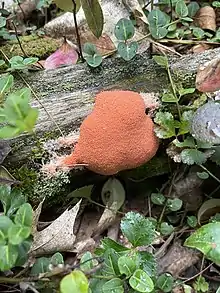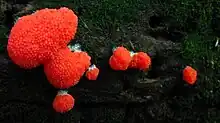Tubifera ferruginosa
Tubifera ferruginosa, more commonly known as raspberry slime mold or red raspberry slime mold, is a species of slime mold in the class Myxogastria. It is one of the most widely known and distinct slime molds, being found throughout temperate regions of the world, primarily in Europe and North America.[4]
| Tubifera ferruginosa | |
|---|---|
 | |
| Tubifera ferruginosa's pink-red pseudoaethalia | |
| Scientific classification | |
| Domain: | Eukaryota |
| Phylum: | Amoebozoa |
| Class: | Myxogastria |
| Order: | Liceales |
| Family: | Tubiferaceae |
| Genus: | Tubifera |
| Species: | T. ferruginosa |
| Binomial name | |
| Tubifera ferruginosa (Batsch) J.F.Gmel., 1791 | |
| Subspecies[1][2] | |
| |
| Synonyms[3] | |
| |
Description
T. ferruginosa is often found growing on damp rotten wood in temperate forests. It forms small, cushion-like "pseudoaethalia", or fruiting bodies from June to November that are bright red when young, and purple-brown when mature. These "pseudoaethalia" are different from the aethelia of other slime molds like Fuligo septica, because they are made of tightly bunched, gelatinous rods, or sporangia. Each individual sporangium is approximately 0.5 mm wide and 3 to 5 cm tall, while the width of the pseudoaethalia can reach 15 cm.[5] The pseudoaethalia is anchored to a surface by the hypothallus, a spongy, raised structure that appears light in color.[3]
Name
The name "ferruginosa" comes from Ferrug-, meaning “rusty” or “rust”; and -osa, meaning “fullness” or “abundance”.[6]

References
- Dmitry V. Leontyev, Martin Schnittler & Steven L. Stephenson (2015). "A critical revision of the Tubifera ferruginosa complex". Mycologia. 107 (5): 959–985. doi:10.3852/14-271. PMID 26240306. S2CID 11862701. Retrieved 22 February 2022.
- "red raspberry slime mold". Minnesota Seasons. Retrieved 22 February 2022.
- "Tubifera ferruginosa". Gary Emberger, Messiah University. Retrieved 22 February 2022.
- "Tubifera ferruginosa (Batsch) J.F.Gmel., 1792". Global Biodiversity Information Facility (GBIF). Retrieved 22 February 2022.
- "Tubifera ferruginosa: The Ultimate Mushroom Guide". Ultimate Mushroom. Retrieved 22 February 2022.
- "Tubifera ferruginosa (Batsch) J. F. Gmel". FloraFinder.org. Retrieved 22 February 2022.